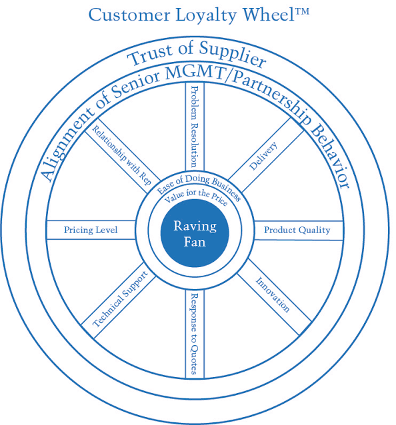This is the second part of “The 23 Keys to Creating Raving Fans” post by Alan Hale from CMG (Consight™ Marketing Group) in Chicago. Don’t forget that you can download the full white paper using the link at the bottom of this post.
In addition to using NPS, we also like to use other diagnostic questions to see how we can improve. In general, it is critical to get the importance level of each function as well as our performance score. If the customer is willing to discuss the competition, the insight will be valuable in how you compare to the competition as well as to the best in class vendor. They also will give you specific actions to improve.
The Customer Loyalty Wheel™
The following is how we look at customer satisfaction, loyalty and creating and Raving Fans.
 It all begins with the trust and alignment and ends in creating Raving Fans.
It all begins with the trust and alignment and ends in creating Raving Fans.
8. A few criteria are explained in further detail.
Trust. If the supplier continually breaks promises they have made, there is no trust. The relationship will not deepen, and in fact might eventually be terminated.
Quality. Quality is an ante to play the game. If your product does not perform according to your specifications or breaks down too often, the account will find another supplier. We had a client who moved their production overseas to reduce costs and increase margins. The quality was very poor and the product frequently broke. The client could not understand why they were losing business!
Risk. Pre-sale, it is important to reduce or minimize the risk factor so the customer is more likely to buy. When you buy the wrong toothpaste at home, your family might be disappointed. When you buy the wrong CRM (Customer Relationship Management) or ERP (Enterprise Resource Planning) system at work, you could be fired. When you sell a product or service new to the market, find out how to minimize risk. This could be having someone on site, providing results from an independent lab, or showing a list of positive testimonials from well- known companies.
Be easy to do business with. Don’t be so difficult to deal with. Exchange the defective product, have customer service solve the problem, issue accurate invoices. Train customer service, give them the power to make decisions up to a certain level. Everything being equal, a customer would rather give business to someone who is easy to do business with. Conversely, if you are 10% of their purchases and 50% of their problems, expect to be terminated. Don’t be a PITA (a pain in the arse). Everyone has problems. Make it easy to resolve. There is research which states customers are more satisfied when a vendor heroically solves a problem versus having no problem at all. We recommend you do not try to game the system i.e. by making artificial problems you know you can heroically resolve.
Be responsive and proactive in communications. We will give you a few common examples from our research. Technical support and sales reps taking days to return a call. The delivery truck is consistently late. If you know you are going to have a delivery problem call the customer. Isn’t that a novel idea? They don’t like surprises, but can make other arrangements and adapt to the issue. Many clients do not want to admit there is a problem. They hope magically it will go away. Sometimes the supplier goes away.
9. New Product Development. I am astounded by the number of companies who continue to develop new products driven by engineers without any significant customer input. Then, they wonder why the product has failed. Once we had a client who had a new commercial ceiling grid system. It was beautiful and architects loved the appearance. The problem was the general contractor would not award our client the project as the sub-contractor was higher than the bids of other installers. Installing this product required 15% more labor. If the installers installed the product after winning the bid, they would be less profitable. No one had bothered to get the input of the ceiling installation contractors.
Another client manufactured lab equipment, and engineering put every feature they could think of making the product 20% more expensive than the competition. The company had a warehouse full of finished goods inventory that was not selling.
10. Ease of Use/UX. The user needs to find the product easy to use. A client, who manufactured sophisticated lab instruments introduced a next generation product, which was way more accurate than anything currently on the market. But it was more difficult to use and required frequent calibration from a third-party. They forgot to obtain the input of the lab technician.
11. Are you a partner or just another supplier? It is important to determine whether you are perceived as a partner or as a mere supplier to your accounts. Your product may be insignificant like a valve and they don’t want a partnership. Or it could be a stainless steel pump on a pharmaceutical skid or a plastic bottle for a soda filling line. You are a partner when you supply a key component. If your product is expensive versus the total cost, or is a key component in making the finished product, you have an opportunity to build a partnership. If you can, be a partner. If you achieve partnership status, ask how you can help your customer achieve their objectives. It will set you apart from the competition.
[signinlocker id=”25973″]
12. Create value. Our formula for defining value in the mind of the customer: V= (B plus or minus CX) / (C+R)™. The formula further explained is V equals value. B equals benefits to the company of using the product or service. CX is customer experience, the interactions with the supplier. These experiences can be positive or negative. C represents cost and R is risk.
If you reduce costs or risks at the same benefit, the value goes up. If the costs and risk stays the same, and you increase the benefits, the value goes up. It is in the eyes of the customer. I went to a baker and got a dozen donuts. They gave me 13 donuts for the price of 12, a baker’s dozen. CPG companies do a much better job at identifying how to add value. Other examples are free technical support, giving clients access to your ERP program to see where their product is in the manufacturing process.
13. Use other data inputs. This can include tracking purchases of key accounts over time, analyzing comments from sales people call reports, assessing commentary on web sites, customer chats, IVR or social media etc.
We would also recommend using a CAP, customer advisory panel of non-competing companies, who meet once a quarter. What should we be doing better? Conduct exit interviews with accounts who churned. Why did they leave? Do not leave this to the sales rep; it is too important. The tenure should be every 18 to 24 months, advisory companies are rotated off the panel, and new companies added.
14. Map the buyer’s journey and moments of truth. Jan Carlzon, the ex CEO of SAS airlines, called these “Moments of Truth”, when customers interact with a company. Some 20 years later, in 2005, A.G. Lafley, Chairman, President and CEO of Procter & Gamble, came up with his own version of Moments of Truth, referring to consumer sales rather than customer service. The objective is to walk in the shoes of your customers and observe their experiences, which helps them make decisions, as well as how your employees interact with your customers. Great experiences create Raving Fans. Bad experiences create brand assassins. There is a whole industry, CX (Customer Experience), that addresses how to improve customer experience. Become active in it.
One needs to plot the buyer’s journey; pre sales, transaction and post-sale. How do they search out and evaluate potential vendors? How do we do? Where can we improve? How can we make your search process easier? I have found a lot of companies are good in both the pre-sale and transaction phases.
However, post-sale is where they fall down. Lack of sufficient customer service and technical support create dissatisfaction. It appears that companies do not want to spend on the backend since they already have the customer. They treat customer service as a cost center. You make Raving Fans by delighting them on their experiences. You do not frustrate them, making them brand assassins. They are comparing your performance to other experiences from other competitors and best of class suppliers. Every time I place an online order, I mentally compare the shopping and ordering experience to Amazon.
15. Close the communication feedback loop. Deliver account specific information to the sales rep of that account. Go back to the account. This is what we heard, is this correct? What else are we missing? How can we improve? Create an account specific action plan. This is what we are going to do. We will meet every quarter to see how it is going. Communicate your performance to the rest of your employees in the organization.
16. Design actionable strategies and tactics in general, as well as for each major account. The CEO needs to drive this across the organization and across silos. It is not owned by marketing, it is owned by every employee in the organization. An example of a general item is customer service. Instead of waiting for the next available rep to pick up, major accounts should be assigned a specific rep with a separate 800 phone number. Your best customer service reps should be a part of this group. Stop treating customer service as a cost center. If you have limited availability of a product, ensure that your high volume customers get enough of the product before you try to allocate some to everyone.
An example of a specific account action plan is having a technical support person available 24/7 so a customer can get support during their third manufacturing shift so the line does not go down.
17. Embed customer responsiveness in the company’s DNA. Results need to be driven across the organization. Marketing needs to work with sales and engineering. There needs to be wholesale buy-in when creating Raving Fans. I think of IBM and Lou Gerstner, and how he turned the company around when it became arrogant. “We are IBM.” It was culture as well as actions. He visited IBM’s major customers. He asked “What are we doing right? Where do we need to change”? And he gave them his business card with his personal telephone number if they ever needed help. As Peter Drucker, a famous management consultant, once said “Culture eats strategy for breakfast.” Strategies are important, but culture is even more important.
18. Alignment and commitment of employees. You need to align effort across silos to implement key initiatives. Many books and papers have addressed this better than I can elaborate. Make sure you communicate the reason for changing the culture and align efforts as well as compensation. Sometimes I see marketing getting huge bonuses from successful product launches, while engineering and sales are just verbally thanked. You need alignment, incentives and employee satisfaction. There has been a lot written about employee satisfaction.
19. Design a physical war room. Plot key metrics, by key account. Examples of these KPI’s (Key Performance Indicators) are NPS, CSat, progress of key initiatives. Here is where we are; here is where we needed to be; here is how we are going to close the gap. Are we on track to meet the dates of the roll out of implementation of initiatives? It should be a place where senior management can pop in and see where we are, and how major customers feel about us along with information like delivery, quality, and YTD purchases. You can do this digitally but it is more effective to see physical data at a glance where it literally surrounds you.
20. Consistent branding. The image and branding needs to be consistent across all platforms like social media and website, across all departments like sales and customer service, and across all channels like distributors. You cannot be easy to do business with when customer service takes 15 minutes to answer a call and then fights you instead of helping you. You cannot be the leader in tech support when the distributors do not know your product or you cannot provide timely support to your customers.
21. Everyone owns the Raving fan process, but the CEO needs to be leading by communicating and walking the talk. Here is how we did this quarter. Like CRM, and ERP, this needs to be an ongoing process not a one-time event. Specific people need to own each initiative and be accountable for results. If everyone owns it, no one owns it. This is one of the reasons Jack Welch was so successful as CEO at GE. He kept communicating initiatives and held people accountable for major initiatives.
22. Offer to work with your customer’s major customers. If you are fortunate to reach a valued partner status, ask your customer if you can help them support their customer’s initiatives. That helps differentiate your customers from the competition by adding more value.
23. Rinse and repeat. Redo the process. Measure every 18 to 24 months after you launch initiatives to make sure you are making progress in the creation of Raving Fans. It is not a one and done process. There is no magic silver bullet to create Raving Fans. It is a journey. Audit then refine your initiatives.
If you would like to download the full white paper then please click HERE.
[/signinlocker]
We wish you much success in your own journey to create Raving Fans. Please feel free to share this white paper with others. If you need assistance or wish to chat about this, and are in the B2B industry, please contact us to see if we can add value. The author of this two-part post is Alan Hale from CMG in Chicago. He can be reached at +1 847-800-1685 or at alanhale.consultant@gmail.com.







